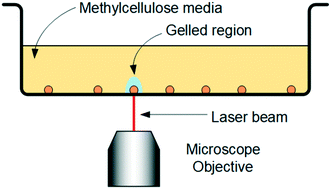Selective cell propagation via micropatterning of a thermally-activated hydrogel†
Abstract
The ability to selectively propagate specific cells is fundamentally important to the development of clonal cell populations. Current methods rely on techniques such as limiting dilution, colony picking, and flow cytometry to transfer single cells into single wells, resulting in workflows that are low-throughput, slowed by propagation kinetics, and susceptible to contamination. Here, we developed a method, called selective laser gelation (SLG), to micropattern hydrogels in cell culture media in order to encapsulate specific cells to selectively arrest their growth. This process relies on the inverse gelation of methylcellulose, which forms a hydrogel when heated rather than cooled. Local heating using an infrared laser enables hydrogel micropatterning, while phase transition hysteresis retains the hydrogel after laser excitation. As a demonstration, we used this approach to selectively propagate transgenic CHO cells with increased antibody productivity. More generally, hydrogel micropatterning provides a simple and non-contact method for selective propagation of cells based on features identified by imaging.



 Please wait while we load your content...
Please wait while we load your content...